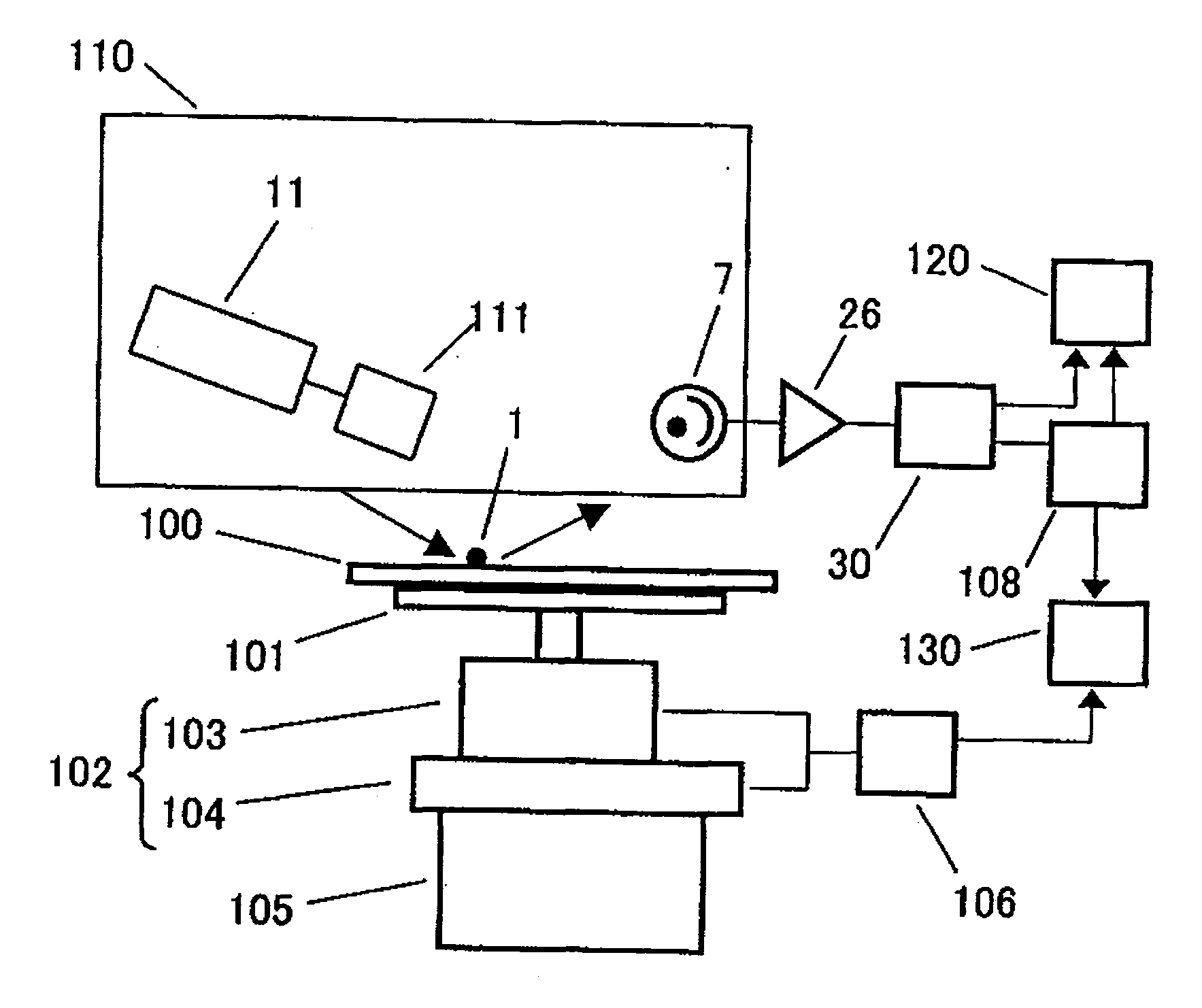Surface Inspection Method and Surface Inspection Apparatus
a surface inspection and surface technology, applied in the direction of material analysis, semiconductor/solid-state device testing/measurement, instruments, etc., can solve the problem of generating a difference in detection sensitivity
- Summary
- Abstract
- Description
- Claims
- Application Information
AI Technical Summary
Benefits of technology
Problems solved by technology
Method used
Image
Examples
first embodiment
[0042]FIG. 1 is a schematic configuration view of a contaminant particle and defect inspection apparatus according to the present invention. In FIG. 1, a semiconductor wafer 100 that is an object to be inspected is vacuum-contacted to a chuck 101, and the chuck 101 is mounted on a movement stage for an object to be inspected 102 provided with a rotation stage 103 and a translation stage 104, and a Z stage 105.
[0043] Illumination and detection optics 110 arranged above the semiconductor wafer 100 are optics shown in FIG. 2 and FIG. 3. FIG. 2 is a plan view of the optics, and FIG. 3 is a side view of the optics.
[0044] In FIG. 2 and FIG. 3, a light source 11 of illumination light in the illumination and detection optics 110 uses a pulse laser which performs pulse oscillation by time repeating light of a wavelength in a UV region. The light outputted from the light source 11 is divided into two illumination beams 21 and 22 by a beam splitter 12.
[0045] The illumination beam 21 reaches ...
second embodiment
[0070]FIG. 5 and FIG. 6 are explanation views of detection optics of the present invention, and showing an example which detect scattered, diffracted, and reflected lights from a plurality of azimuth directions by arranging detection optics in a plurality of directions in which a plurality of elevation angles and a plurality of azimuthal angles are combined. In addition, FIG. 5 is a plan view of the detection optics; and FIG. 6 is a side view of the detection optics.
[0071] Illumination optics in the second embodiment of the present invention is equivalent to the first embodiment, and therefore their explanation will not be described herein.
[0072] A detection system of scattered, diffracted, and reflected lights in the second embodiment of the present invention includes a first elevation angle detection system 70 including four condenser elements 71 which have first substantially equal elevation angles, differ each other with respect to a primary scan rotation axis of a movement sta...
third embodiment
[0086] In the present invention, time instant and interval of time at which illumination light are actually irradiated to the respective illumination spots 3 and 4 can be exactly known by the former light emitting timing signal generating units (14, 15, 16, and 17). Consequently, if an output signal shown in FIG. 11(E) from the photodetector 7 is separated using the light emitting timing signal, it is possible to separate the scattered, diffracted, and reflected light signals from a plurality of the illumination spots 3 and 4 and to detect using one photodetector 7 only.
[0087] More specifically, an output signal of the photodetector 7 is processed by a separation circuit having a configuration shown in FIG. 13. That is, the output signal of the photodetector 7 is amplified by a preamplifier 25, and then, distributed into two gate circuits 27a and 27b. ON and OFF operations of the respective gate circuits 27a and 27b are controlled in accordance with the light emitting timing signals...
PUM
| Property | Measurement | Unit |
|---|---|---|
| angle | aaaaa | aaaaa |
| azimuthal angles | aaaaa | aaaaa |
| Brewster's angle | aaaaa | aaaaa |
Abstract
Description
Claims
Application Information
 Login to View More
Login to View More - R&D
- Intellectual Property
- Life Sciences
- Materials
- Tech Scout
- Unparalleled Data Quality
- Higher Quality Content
- 60% Fewer Hallucinations
Browse by: Latest US Patents, China's latest patents, Technical Efficacy Thesaurus, Application Domain, Technology Topic, Popular Technical Reports.
© 2025 PatSnap. All rights reserved.Legal|Privacy policy|Modern Slavery Act Transparency Statement|Sitemap|About US| Contact US: help@patsnap.com



